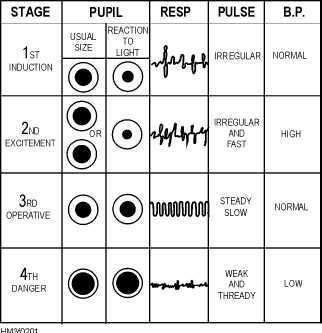Topical anesthesia is administered topically to
desensitize a small area of the body for a very
short period.
Local blocks consist of the subcutaneous
infiltration of a small area of the body with a
desensitizing agent. Local anesthesia generally
lasts a little longer than topical.
Nerve blocks consist of injecting the agent into
the region of a nerve trunk or other large nerve
branches. This form of anesthesia blocks all
impulses to and from the injected nerves.
Spinal anesthesia consists of injecting the agent
into the subarachnoid space of the spinal canal
between the third and fourth lumbar space or
between the fifth lumbar and first sacral space of
the spinal column. This form of anesthesia
blocks all impulses to and from the entire area
below the point of insertion, provided the
patient’s position is not changed following
injection of the agent. If the patient’s position is
changed, for example, from dorsal recumbent to
Trendelenburg’s, the anesthetic agent will move
up the spinal column and the level of the
anesthesia will also move up. Because of this
reaction, care must be exercised in positioning
the patient’s head and chest above the level of
insertion to prevent paralysis (by anesthesia) of
the respiratory muscles. In general, spinal
anesthesia is considered the safest for most
routine major surgery.
Epidural blocks consist of injecting the agent
into the epidural space of the spinal canal at any
level of the spinal column.
The area of
anesthesia obtained is similar to that of the
subarachnoid spinal method. The epidural
method is frequently used when continuous
anesthesia is desired for a prolonged period. In
these cases, a catheter is inserted into the
epidural space through a spinal needle. The
needle is removed, but the catheter is left in
place. This provides for continuous access to the
epidural space.
Saddle blocks consist of injecting the agent into
the dural sac at the third and fourth lumbar space.
This form of anesthesia blocks all impulses to
and from the perineal area of the body.
Caudal blocks consist of injecting the agent into
the sacral canal. With this method, anesthesia is
obtained from the umbilicus to the toes.
General Anesthesia.—General anesthetics cause
total loss of sensation and complete loss of
consciousness in the patient. They are administered by
inhalation of certain gases or vaporized liquids,
intravenous infusion, or rectal induction.
The
induction of inhalation anesthesia is divided into four
s t a g e s .
T h e s e s t a g e s a n d t h e b o d y ’s m a i n
physiological reaction in each phase are explained
below and depicted in figure 2–1.
Stage 1 is called the stage of analgesia or
induction.
During this period, the patient
experiences dizziness, a sense of unreality, and a
lessening sensitivity to touch and pain. At this
stage, the patient’s sense of hearing is increased,
and responses to noises are intensified (fig. 2-1).
Stage 2 is the stage of excitement. During this
period, there is a variety of reactions involving
muscular activity and delirium. At this stage, the
vital signs show evidence of physiological
stimulation. It is important to remember that
during this stage the patient may respond
violently to very little stimulation (fig. 2–1).
Stage 3 is called the surgical or operative stage.
There are four levels of consciousness (also
called planes) to this stage.
It is the
responsibility of the anesthetist or
anesthesiologist to determine which plane is
optimal for the procedure. The determination is
made according to specific tissue sensitivity of
2-17
Figure 2–1.—Stages of anesthesia.

